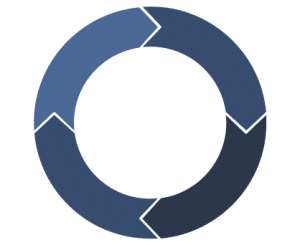The Teaching Cycle in FE – What Is It?
Teaching Cycle
What is the teaching cycle? The teaching cycle is a continuous cycle that a teacher or trainer in the FE sector performs. You will complete the teaching cycle process any time you participate in teaching, whether in an online classroom or a traditional classroom setting.
The teaching cycle is important to teachers and trainers, as it will give clarity to you and your learner. It also contributes to the roles and responsibilities that applies to teachers. There are 5 stages to this teaching cycle, so lets go through each of them.
Stage 1 – Identifying Needs
In stage one of the teaching cycle, you will need to find out what your learner’s need are. You will also need to find out what your learner’s expectations are and what they want to get out of the programme. Establishing the learners learning styles or preferences when it comes to learning is essential.
You should also carry out any initial assessments on your learner, or diagnostic assessments to get a better feel for what they need. Whether it’s agreeing to individual learning plans and needs, or finding out if your learner has any specific needs; the initial assessment will likely be the source to find this out. For example, if the learner has any impairments, such as visual or hearing, you need to find this out and then assess how you can support them.
At this stage of the teaching cycle, you need to ensure that each student is capable of achieving the set goals, as well as making sure they progress in their learning. This starting point is all about the needs of your learner, and helping them progress to the next stage. Not forgetting to make sure you give them as much help and guidance.
Stage 2 – Planning Learning
The next stage of the teaching cycle is planning learning. This is preparing schemes of work, as well as lesson plans. You’ll be creating materials to ensure you cover all the criteria and the requirements of that programme.
The lesson plan has thorough enough that expectations are met. When doing this, you may want to to consider the course length and how many learners you have. You may want to create a lesson plan using different teaching methods and styles. This will take into account the learning styles of your learners. However, not all students are going to learn the same way, so it might be worth changing it up from time to time. Don’t forget to consider any resources that might have to be used.
Stage 3 – Facilitating Learning
This stage of the teaching cycle is about the delivery. As teacher, you need to deliver a range of lessons. You need to deliver lessons in a way that engages students and encourages. Students should feel motivated and be enthusiastic about the material.
You also have to make sure that the learners are aware of and understand the aims of the lesson. It’s best for students to know the outcomes expected for when they leave the lesson.
You will need to deliver the lesson plan using various resources and activities. These could be worksheets or Q&As for example. As well as the various teaching methods that were designed in the planning learning stage of the teaching cycle. You may need to adapt the lesson to specific requirements.
Stage 4 – Assessing Learning
You are responsible for the continuous assessment and development of students. In order to ensure that students are involved and they understand the session, it’s important that you use a range of different assessment methods. Check if your learners have gained necessary skills and knowledge, in addition to understanding at all stages.
At this stage of the teaching cycle, you may wish to consider one of two popular assessments; formative and summative. What does that mean? Let’s have a look.
Formative Assessment
Formative is monitoring student learning. This provides ongoing feedback which will be used by you, to improve the teaching. As well as improving student learning. This helps students identify their strengths and weaknesses. To also know their target areas that need more work. This in turn helps you recognise where your learners are struggling.
Summative Assessment
Summative is to evaluate students learning. This would take place at the end of a unit, which you can then compare against a standard/benchmark. This could be an exam, a project, or an essay. This is to guide your efforts when considering next activities or courses for your learner. Where you go next with them, and what areas need more work.
Both of these are to provide the student and teacher a clear understanding of the progress and knowledge that is being made by the learner. Each assessment you use needs to be reliable and consistent, to enable you to provide help or make changes to improve student progress.
Stage 5 – Evaluating Learning
This last stage of the teaching cycle is all about the evaluation of learning and progress, and then making the changes. This is a stage to get feedback from others. They reflect on your role and all the aspects that are involved with learning in order to make improvements and to change things.
All of these aspects should focus on the learner and internal quality assurance and standardisation of practice should take place throughout.
If you have any questions about the teaching cycle, drop us a comment below or send an email to training@brooksandkirk.ac.uk.

